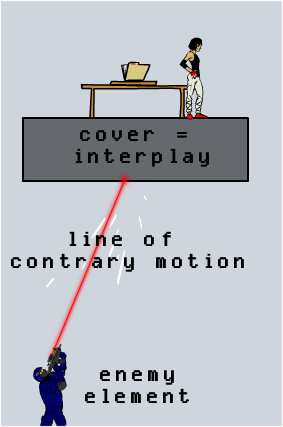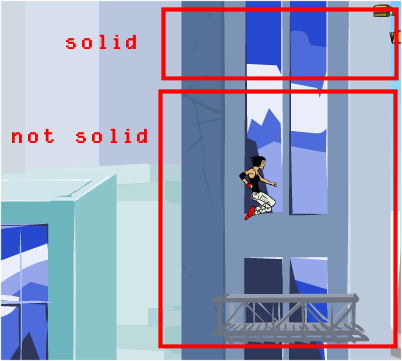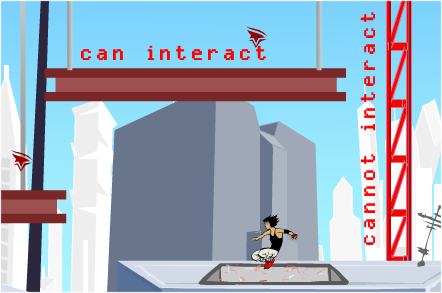The Flash, 2D Mirror's Edge game is very similar to the 3D version in a number of ways. Because the game can be completed in a matter of minutes, the content of 2DME is comparatively minuscule to its 3D sister. Devoting an entire entry to 2DME would result in an similarly short article. For this reason, as I detail the design of 2DME, I'll also touch upon how the perspective (2D/3D) of each game has shaped its design layer by layer.

Core Mechanics

RUN. JUMP. DUCK/SLIDE. CLIMB/WALLRUN. Like in 3DME, 2DME's core mechanics are well tuned and highly polished to allow the player to smoothly transition between one action to another. Interacting in a 2D environment and a 3D environment are inherently different. In a 3D world, everything exists in 3 dimensions which, when a dynamic perspective is considered, gives even the smallest movement a weightier impact. This is why Faith's JUMP in 3DME is kept realistically close to the ground. In first person, the greater the movement, the more disorienting the game can become.
In a 2DME, the JUMP and WALLRUN mechanics are exaggerated giving players the ability to maneuver vertically with ease. The platforming/level design in 3DME isn't designed with a lot of verticality. When moving through 3D space, moving through the X and Z axis while punctuating the Y axis is enough to make good use of the space. But in 2DME, Faith must be able to use more of the available space considering the lack of a 3rd dimension. For vertical maneuvering, Faith can control her vertical motion by sliding along walls, grabbing onto pipes, wall running, and landing on slanted surfaces. In 2DME players have more ways to prevent Faith from dying from large falls. These abilities allow for the level to be designed equally in all 4 directions. More on that later.
LEVEL ELEMENTS
Both the 2D and 3D Mirror's Edge games have a variety of similar level elements. From poles to climb on and swing off of, spring vault objects, wall ride-able walls, to slides, both games took these urban objects and made them functional for the platforming player. And like the 3D Mirror's Edge, none of these elements can be moved, changed, or transformed in any way. This design makes the game worlds for both games non responsive and impersonal as if it's only meant to be passed through quickly.
While 3DME represents these objects with a degree of realism in their forms, the visual forms of these level elements in 2DME embrace the interpretation of 2D space for the side scrolling perspective. At one moment, 2D Faith will be unable to stand up on a red pole, and in the next moment, she'll be running at full speeds along a power line wire. Likewise, some platforms will appear to be floating in the middle of space. But all of this is familiar to us by now. Since games like Super Mario Brothers, we've gotten used to the artistic interpretation of 2D game worlds. Though it may seem a bit abstract compared to 3D game worlds, we still get the picture.
ENEMY ELEMENTS

2DME only has one enemy element; the gunman/guard. This enemy can only be found in the 6 secret areas hidden throughout the 2DME's 3 levels. Faith can only sustain about about 3 hits or so from the guard's machine gun before dying and repawning. Unlike 3DME gun wielding enemies, these guys can't be harmed at all.
While a 3D game world viewed through a first person perspective can easily obscure the location of enemies, in a 2D world things are much simpler. The enemies in 2DME can only fire in a straight line. Basically, instead of triangulating the enemies position in 3D space, figuring out where an enemy is aiming in 2DME is as easy as picturing a straight line. To make this easier, the 2DME enemies are drawn with a laser sight that projects the line for you on the screen (see image above).
The dynamics of fighting the 2D guards are easy to understand. Like in 3DME, level elements can provide cover from gunfire. If the laser sight is obscured, then so are the incoming bullets. After firing a round, the gunman will reload. This break in the assault creates clear stop and go opportunities for action. Because of the laser sight, it's easy to see how limited the gunman's aim is. Though he'll automatically aim at Faith whenever she pokes out of cover (once again, this is determined by simple straight lines), he can only move his gun so fast. Because of these design features, you can mislead the gunman's attention by peeking out of cover and then maneuvering away from that area. ALso the 2D design creates a simple dynamic of rotation aiming in 2D space. Basically, the closer Faith is to the gunman, the less distance she has to move to dodge out of the way of the gun's sights. The farther away Faith is, the easier it is for her to be shot.
Many shooter games create dynamics between close range and long range combat. But few do so simply and organically. In 3DME, when close to an enemy, the enemy AI will switch back and forth between shooting and going in for a melee attacks. The general reason for this complicated and somewhat artificial AI design is that the 3D space in 3DME is functionally made up in part of a 2D top down plane where enemies are typically designed with more complex behavior and pathfinding. Because Faith can only disarm opponents when they use melee attacks, it's as if the game is giving players an opportunity to overcome the enemies when there wouldn't be an opportunity otherwise. Any reasonably smart gunman (or seasoned Halo player) knows that if your opponent doesn't have a firearm or if the opponent has run out of bullets, the best strategy is to keep your distance from the target and shoot especially when you have the strength in numbers. In this way, 3DME gun wielding enemies aren't stupid enough to be simple (like a Goomba or the 2DME enemies) and are too stupid to be convincing like the enemies in quality first person shooters. Though the enemy design in 2DME may seem simple, at least it's dynamic, clearly communicated, and effective.
LEVEL DESIGN
The three levels in 2DME are designed like the levels in Sonic Rush. Following the simple idea of when players mess up a platforming challenge they fall, the levels are designed so that the trickier platforming paths are stacked on top of easier and easier platforming paths. Generally, the dichotomy between the high and low areas are also set apart by speedy, smooth platforming stacked on top of slower, more cumbersome areas. In other words, when you fall to the bottom of a level in 2DME, you can expect some slower climbing area and more "speed bumps" in the level design to sort of punish you for messing up before.
Check out this speed run of the first level. This is the fastest path this player has found through the course. Notice how he doesn't drop to any of the lower areas. At most opportunities, he climbs.
Like its 3D sister game, 2DME levels are composed of explore, puzzle, and battle/challenge areas.
EXPLORE
- In 3DME, moving through the large, 3D environments is engaging in and of itself. In 2DME, the levels are designed with a lot more verticality. Like in Spelunky, the 2DME levels seem to be designed in 3-4 layers. To encourage players to explore the large 2D levels players can collect small, red Mirror's Edge logos which are functionally similar to coins in Super Mario Brothers. Even without knowing what they're for, players tend to go out of their way to collect these bonus elements. A handy bit of HUD in the upper right corner displays how many logos the player has collected and how many logos each level contains. Though these logos are fairly effective at influencing the player, their function in the overall design of 2DME is fairly weak especially compared to Mario coins. Aside from possibly unlocking modes, the logos don't have any real function in the game. They don't earn extra lives and they aren't powerups. Any challenge that the player might go through to obtain these logos is somewhat minimized due to the infinite continues and the check point respawn system. Basically, there's no risk and no reward for going after the logos. Generally, you'll explore around in 2DME because there's really nothing else to do.
PUZZLE
- Special bags are positioned in each level in 2DME. Each bag is placed off of the common paths that players can take through the level. To reach a bag, players must understand the limitations and nuances of their platforming mechanics in addition to the layout of the nearby level elements. In this way, the bags signify puzzle areas that are functionally similar to the bonus stages in Super Mario Brothers. These areas from both games are also optional giving the player the choice to seek or leave them at they wish.
BATTLE
- By falling through the occasional red glass skylight players can enter special challenge rooms. In these rooms, players have to avoid the gun fire of a patrolling guard while platforming through the room to reach a secret folder. Though there are only 6 of these rooms in the game, I found each to be well varied from each other. The bit of contrary motion, interplay, and spatial dynamics that the guard brings to the platforming design of 2DME makes these rooms stand out as highlights of the game.

The visual design if 2DME has a few core issues. In the first level especially, it's evident that the look of the game was made or prioritized over the function. There are many level elements in the game that Faith can interact with. At the same time, there are many cases and other level elements in the game that look like they'll either be interactive or non interactive yet they defy expectations. In the image above, Faith is falling in front of a building. But, if I had jumped a bit earlier, I would have interacted with the side of the building and climbed up. There is no visual difference between the part I can climb and the part I pass through. Form fits function is very important in a video game, and it's cases like this that work against the visual communicative integrity of the entire game.

At first I thought the visual design of 2DME used the color red in a similar way as the 3D version, ie. to inform the player of specific level elements that can and should be interacted with to progress. But there are cases in 2DME where red means "can interact" and cases when it doesn't. The one color that should have been used sparingly was apparently used disregarding this function.
In the end, 2DME is a lot like 3DME. Both have visual/presentation issues. Both have mostly solid mechanics, level, and enemy elements. And both games fall short when putting all the pieces together. Many parts in both games are nice. But nice isn't amazing. And I see so much amazing potential in the pieces. I believe that everything is either made or broken in the level design. Even without adding too many elements or making very many tweaks, repairing either of these games is a matter of understanding the dynamics of counterpoint and embracing some underutilized high quality level design, which I've covered extensively already. So, for part 3 I'll do a little proposing and rearranging in attempt to give you a glimpse at why I look forward to the inevitable sequel to Mirrors Edge.